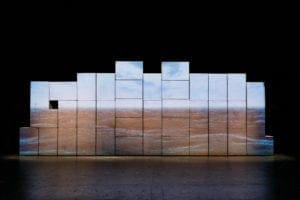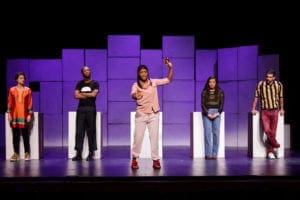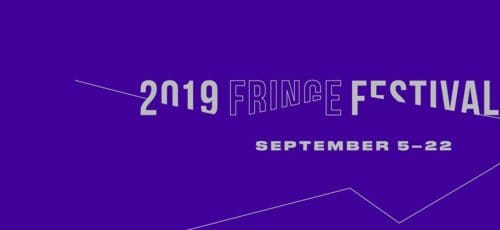Mapping the Refugee Experience: Kaneza Schaal and Christopher Myers on Cartography
How do we track where we’ve been, where we are, and where we’re going, especially when we must flee our homes? Cartography, by Christopher Myers and Kaneza Schaal seeks to answer this question. Inspired by conversations with young refugees in Munich, Germany, Myers and Schaal co-created a piece of theater that puts these migrants on stage and tells their stories.
This all-ages theater follows the struggles, hopes, and experiences of five young migrants from diverse backgrounds as they navigate the refugee process. The audience is also invited to share their stories, interacting with the stage from their cellphones. FringeArts talks with Christopher and Kaneza about their piece, which will be performed in Philadelphia September 12–15 as part of the 2019 Fringe Festival.
 FringeArts: What inspired Cartography?
FringeArts: What inspired Cartography?
Christopher Myers: Cartography grew out of our work in Munich 2016 with young people who came to the city on their own from around the world.
Earlier that year, The New York Times had reported 30,000 people were arriving in Munich each day. We asked ourselves what we had to offer, as artists to this moment. The kids we worked came from Mali, Afghanistan, Iraq, Somalia, Eritrea, Nigeria, and Syria. They had crossed oceans in inflatable rafts, walked through forests, hid themselves in the holds of cargo trucks. At the end of our work together, when we asked the group, “What should we do next, what do they want from us?” they said, “We want a place to be seen.” They said that after spending so long having to hide, where invisibility was part of survival, being seen was the most valuable part of our time together. They said we should create places for kids like them to be seen.
Cartography is our answer to this request. The piece creates a platform for audiences to consider their own histories of movement, how we all place ourselves in the continuum that lead to this historical moment of the largest mass migration in human history.
Kaneza Schaal: For us, the most powerful part of the work in Munich was creating a context for young people to think together about these questions. There was a group of girls working with us who all lived in the same residence. We did a mapping exercise where each participant drew their journey. A girl from Nigeria and girl from Syria, who had been living together for three months, realized for the first time that they had both been on inflatable rafts in the Mediterranean. One had lost her brother over the side of the boat, one had been raped on the journey and arrived in Munich pregnant. The girl from Nigeria turned to the girl from Syria and said “We must go home to tell our sisters not to get on these boats.”
Cartography is a platform to centralize young audiences to thinking together about this historical moment.
FringeArts: What interests you about the perspective of youth and young migrants specifically.
Kaneza Schaal: Young people are at the forefront of this historical moment. These kids live across time zones, digital platforms, and languages; between memories and imaginations and a communications web that stretches from the bomb shelters of their former schools to European job training programs to cell phone videos of their cousins. Centralizing the exchange between young people allows all of us to better understand the ‘in-between-ness-es’ that are central to lives in motion.
FringeArts: What do you look for in your collaborators? What do they bring to the work?
Christopher Myers: The strongest tool of an ensemble is the culture of the group. We look for people who assemble a vast lexicon of creative, cultural, formal, historical, aesthetic languages from which to create. We look for people who are fun
FringeArts: What characteristics did you look for in the performers? What themes and ideas do you discuss in the rehearsal process?
Kaneza Schaal: I look for desire. A desire to be seen, a desire to communicate, and a desire to think about big questions.
Each performer on this project has a deep personal connection to thinking about exile, forced movement, immigration, and migration. The emotional grounding point of the performance lives in their own bodies and their own stories. All of our family stories were central to this work.
 My family fled Rwanda during the 1960s and lived as refugees in Burundi. As the story goes, the next day my grandfather woke up at the crack of dawn and went to collect bananas and sell them in the market. He passed other men whose families also fled, sitting at roadside bars, they laughed, “Why are you working? We will all be going home soon.” Eventually he sold enough bananas to buy a pot to make banana wine, enough banana wine to buy a shack, and later turned the shack into a motel.
My family fled Rwanda during the 1960s and lived as refugees in Burundi. As the story goes, the next day my grandfather woke up at the crack of dawn and went to collect bananas and sell them in the market. He passed other men whose families also fled, sitting at roadside bars, they laughed, “Why are you working? We will all be going home soon.” Eventually he sold enough bananas to buy a pot to make banana wine, enough banana wine to buy a shack, and later turned the shack into a motel.
I grew up visiting my family in Burundi. It was not until after the 1994 Rwandan genocide that any families were able to repatriate. My father never made the switch, for him Burundi was home. His rooted understanding of in-betweenness is a generational gift I received
For over a decade I have worked in NYC public schools with recently arrived young people. Some walked across borders, some immigrated through family, some arrived as asylum seekers. I use performance to help map the chasms they traverse. Together we create worlds that can hold the many truths and stories that come with complex political, social, economic, and personal movement.
FringeArts: Can you describe some of the various media used in Cartography? How do they contribute to the themes and ideas you explore?
Christopher Myers: For the children and families who have migrated, especially those crisscrossing the Mediterranean, the sea itself functions as a mystical, untethered character like the unpredictable gods of Greek tragedy. How do we interpret its motions, allowances and punishments with any degree of rationality as ancient tales of Mediterranean migration have? There figures like Scylla and Charybdis stood in for the dangers of the sea. We understand the ocean itself as a character and embody it on stage, so we developed a system by which we can project an image of an ocean and have actors on stage control the intensity of the waves and wind with the timbre of their voices and movements, thus inverting the experience of most migrants who find themselves tossed about by the sea.
Cell phones have become increasingly integrated with the fabric of everyday life, from mapping to financial institutions, from being in constant contact with loved ones to finding resources in resource-poor environments. Nowhere is this more evident than in the lives of contemporary migrants who may do without food or water, but need their cell phones as a resource before all others. In the theater, so often, the cell phone is asked to be shut off, we’d like to utilize these tools of travel in our storytelling. Various kinds of content could be relayed across a device to supplement and enrich the storytelling on stage, text messages, maps, images, etc. We look forward to a partnership with technological thinkers to brainstorm, plan, and/or prototype a delivery systems for raw materials of migration.
What: Cartography
When: Sept 12–15, 2019
Where: Christ Church Neighborhood House, 20 North American Street
Cost: $15–$35
Created by: Christopher Myers and Kaneza Schaal
Photos by elmanstudio



